|
1.
CENTRAL/ WEST AFRICA
Log prices hold steady through August
Log prices held steady through August, marking a rebound from weaker price trends in July. Only
two or three downward adjustments in price were recorded, due to changing supply and demand.
Price stability was assisted by the slight improvement in demand from China,
although demand was still far from reaching previous levels. Azobe was one of the main species suffering a drop
in price because of oversupply, reduced interest from the Netherlands and strong competition from
alternative Brazilian species. Prices also dropped for Padouk, since fewer ships were available for
loading to India.
Gabon¡¯s new log quota system is fully implemented, although there are still ongoing discussions
with government on allowable volumes. It is reported that some companies were allocated volumes
of around 10% of their previous export volumes. Although negotiations on the
allowed quotas will continue for some time, there is a connection between the allowed quotas and companies¡¯
reforestation records. This connection appears to have assisted the longer established companies
in the allocation of total export volumes.
For sawn lumber, Sipo and Sapele prices remained firm. Prices for other species are strong and the price increases
achieved through June and early July have held. Although markets are currently
quite dull, prices have stayed buoyant and thus there is still confidence in market
prospects in the fourth quarter.


2. GHANA
TIDD reports record expansion in trade volume
The Timber Industry Development Division (TIDD) of the Ghana Forestry Commission indicated that
Ghana¡¯s trade volume from January to June 2007 reached a total of 2.66 million m3 and was worth
over USD93 million. This was a 22% surge in volume and a 9.5% hike in value from the
previous year¡¯s figures.
Wawa, Ceiba, Ofram, Mahogany, Asanfina, Niangon and Odum featured prominently in the exports
of rotary sawnwood and sliced veneers, plywood and furniture parts. Plywood (including overland
exports), lumber (KD) and lumber (AD) contributed 24.0%, 21.2% and 15.5%, respectively, to the
total volume of timber exports for the half-year period. Compared to the same period in 2006,
plywood was up 64.7% in volume while lumber (KD) and lumber (AD) slipped 0.80% and 24.1%,
respectively.
Tertiary wood products accounted for 9.0% (EUR8.39 million) of total revenue for 2007 against
11.7% (EUR9.95 million) in January to June 2006, dropping by 15.7%. Secondary wood products,
however, were 12.9% higher in value over 2006, reaching EUR84.61 million.
Overland plywood exports accounted for 80.7% (51,527 m3) of the overall total export volume for the
period. The leading exporters of plywood included Naja David Veneer & Plywood (37.6%), John Bitar Company Ltd (13.2%),
Ghana Plywood (11.1%) and Asuo Bomosadu Timbers (10.5%), with ten other companies accounting for the
remaining 27.6%. Nigeria was the main plywood importer from Ghana, registering about 69.5% (35,813 m3) of total
volume. This was closely followed by Niger with 14.9%.
While lumber (KD) recorded a marginal percentage drop of 0.8% in export volume for 2007 (56,020
m3) compared to 2006 (56,470 m3), lumber (AD) slumped 24.1% in volume to 41,260 m3 in 2007
from 54,400 m3 in 2006. Curl veneer exports recorded increases of 26.4% and 41.6% in volume and
value, respectively, for 2007. Exports of rotary and sliced veneer receded 6.6% and
2.1% in volume, respectively, for 2007.
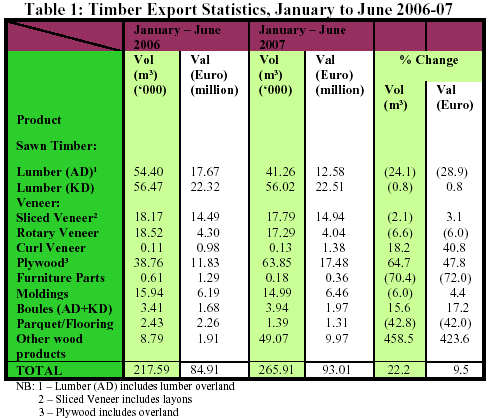
Parliament debates Timber Utilization Contracts
The Ghanaian Parliament discussed the adoption of a motion on Timber Utilization Contracts
(TUCs) allocated under the Competitive Bidding Process in 2004. Mr. Joseph Henry Mensah,
Member of Parliament for Sunyani East, called on parliamentarians to revisit the financing of
the timber business in Ghana, saying non-timber financiers were taking away key business
opportunities. The Parliamentary Committee Report on the TUCs was prepared by the Committee of Lands and Forestry in
response to a request by the House, to enable closer scrutiny of a resolution that would grant TUCs to four timber companies.
The Parliamentary Committee recommended that the Forestry Commission should agree on a
schedule of payments for the outstanding 60 percent of Timber Rights Fees, which should be
submitted to the Committee for Monitoring. It also urged the Forestry Commission to
ensure that the timber companies fulfil the requirements set out in a Social Responsibility Agreement to provide
potable water, school infrastructure, access roads, clinics, electricity, a library and an endowment
fund.
The Timber and Woodworkers Union (TWU) of the Ghana Trade Union Congress urged Parliament
to enact laws making it mandatory for all companies in the timber industry to undertake
afforestation projects to enhance the country¡¯s policy of sustainable forest management. TWU,
a wood-based union, commended the government for its initiative on plantation development
programmes and called for transparency in the disbursement of the Plantation Development Fund to
encourage greater contributions.
Ghana sets sight on single digit inflation
Ghanaian news agencies reported the results of the Deputy Government Statistician¡¯s press
conference in which he announced inflation had fallen to 10.1% in July. The new
annual percentage rate dropped 0.6 percentage points from 10.7% in June. The Deputy Government Statistician said
there was a strong indication that single-digit inflation could be reached within this year, unless
there was a radical change in government policy or other exogenous change in government policy or other exogenous
factors. In the 2007 budget, the government projected that annual inflation would
be 8.8%.
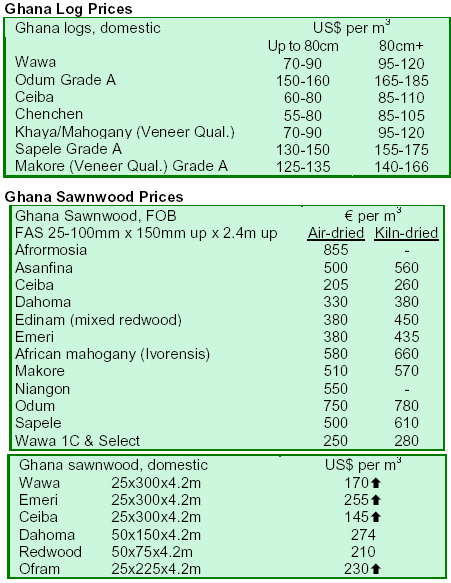
3.
MALAYSIA
Malaysia mulls use of RFID to prevent timber theft
The Star Online reported that Malaysia is considering the use of Radio Frequency Identification
(RFID) chips to prevent timber theft. The Parliamentary Secretary of the Ministry of Natural
Resources and Environment said in a recent meeting that the technology would enable
authorities to track species data and the location of harvested trees. The Secretary said the proposal to use
the RFID would soon be presented to the Malaysian Cabinet.
Malaysia backs Japan¡¯s approach to climate change
Malaysian Prime Minister Datuk Seri Abdullah Ahmad Badawi and Japanese Prime Minister Shinzo
Abe discussed the need to cut global greenhouse gas emissions by half from its current level by
2050, reported The StarOnline. Abdullah backed the Japanese approach to stabilize atmospheric
concentrations of greenhouse gases as proposed in the ¡°Cool Earth 50¡± initiative announced in
May 2007. Abdullah and Abe shared the view that it was important to promote sustainable forest
management in Malaysia to help mitigate greenhouse gas emissions and conserve biodiversity.
Malaysian posts lower production and exports growth
Malaysia posted weaker than expected results for exports and industrial production growth in June,
reflecting almost flat gross domestic product (GDP) growth for the second quarter. According to
official data, Malaysia¡¯s industrial production for June grew at a slower pace of 0.5% from a
year earlier after exports fell 0.4% during the same month.
Malaysia dispatches trade mission to Latin America
According to Bernama, the Malaysia Deputy International Trade and Industry Minister, Ng Lip Yong,
will lead a trade and investment mission to Argentina, Uruguay and Brazil from 23 September to 5
October. The Malaysia External Trade Development Corporation (Matrade), reported that the
mission would explore business opportunities in Latin American markets. Wood products
and furniture are among the export opportunities for Malaysian companies in the region.
South Africa is Malaysia¡¯s biggest African trade partner
Malaysian International Trade and Industry Deputy Minister Ahmad Husni Hanadzlah said at a
recent South Africa Business Opportunities meeting that South Africa was Malaysia¡¯s largest
trading partner in Africa. Malaysia¡¯s total trade with South Africa reached
USD447.4 million between January and May 2007, an increase of 14.9% from USD368.1 million in the same
period last year. Malaysia had a strong presence in South Africa, with 38 companies investing USD71.4 million in
companies, including construction and property development, wood-related industries and palm oil.
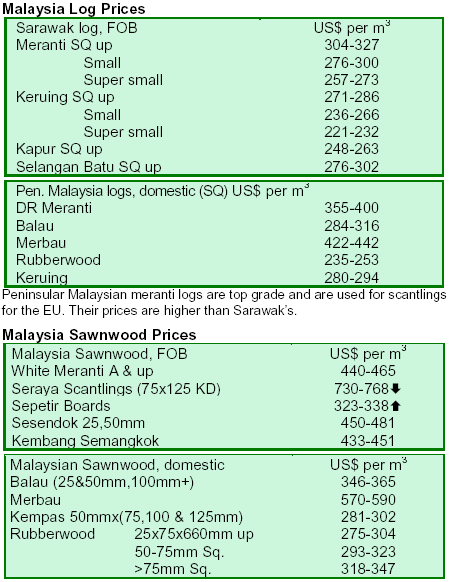
4.
INDONESIA
Indonesia aims at doubling trade with Qatar
Antara News reported that a senior Indonesian government official said that Indonesia, which
enjoyed a trade surplus with Qatar, would aim to double its trade with the oil-rich
state. He added that the Indonesian trade balance in 2007 would exceed the total value in 2006 and almost double
as several export commodities entered the Qatari market, including building materials and cement.
Based on Indonesian trade statistics, Indonesia¡¯s trade surplus with Qatar reached USD57.4 million
in 2006, with exports totaling USD69.8 million and imports at USD11.6 million.
Indonesian exports included furniture, plywood, block board and paper.
Indonesia casts doubt over industrial growth targets
As reported by Antara News, Indonesian Industry Minister Fahmi Idris said the government was
expected to revise downward its industrial growth targets. Although the target of the country¡¯s
industrial growth was set at 7.9% for 2007, first quarter results reached only 5.83% from
growth in new industries. The figures were expected to be revised since industries had been facing energy
and raw material supply problems.
The Minister noted that the pulp industry, the fifth largest foreign exchange earner to the country,
was facing problems following a dispute over implementation of government regulations on illegal
logging activities.Production at PT Indah Kait Riau and PT Riau Andalan Pulp and Paper had been
severely disrupted over the last eight months, after police sealed plantations supplying the
raw material for companies. As a result, the Minister doubted whether the target set at 12.47% for the
pulp and paper industry could be met. It was estimated that one million workers could be affected
by the two Riau province paper companies¡¯ problems.
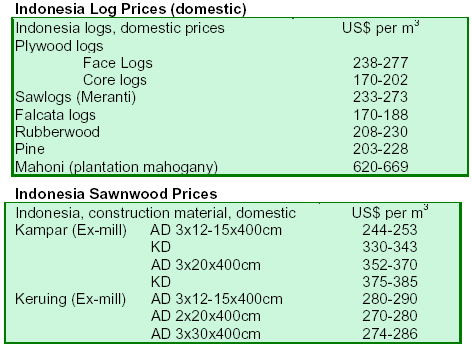
5.
MYANMAR
Volatility characterizes teak prices in August
At the end of August, teak prices were volatile. Prices for higher grades were down, while the
reverse was true for lower grades. The fluctuation in prices for teak and hardwoods was largely due
to changes in supply and demand.

There were few pyinkado logs sold in August and the
market for fresh logs was improving.

6. BRAZIL
Consumer Price Index drops in July
According to the Brazilian Institute of Geography and Statistics (IBGE), the Consumer Price Index
(IPCA) in July was 0.24% less than the previous month. In July 2007, the average exchange rate
was USD1=BRL 1.88, compared with July 2006, when it reached USD1=BRL 2.19. The prime
interest rate (SELIC) would remain at 11.5% as determined by the Monetary Policy Committee in
August, with the next meeting to be held in early September.
Improved fines collection could help stop illegal logging
According to the Man and Environment Institute of the Amazon (IMAZON), the Brazilian Institute ofEnvironment and Renewable Natural Resources (IBAMA)
would need to increase the collection of fines by 28 times to fully stop illegal logging. These estimates, presented in
Folha Online, revealed that fines would need to be increased from their current 2.5% collection rate to 70% in
order to reach the stated collection target. IBAMA would need to improve law enforcement and judicial
capacity in order to increase its efficiency, since the agency did not have the ability to collect most
of the fines charged. Between August 2004 and August 2006, the total number of fines issued
reached 19,762. If the total amount of these fines were collected, it would bring BRL 4.97 billion to
government funds.
Estimates show that collecting 70% of the fines would trigger a fall in illegal logging in the Amazon.
The logic is that the environmental actors would deem legal logging activities as more economically
viable if there is a high economic risk association with illegal activities. Increasing
control efforts by IBAMA would be an expensive, alternative way to sufficiently stop any unlawful logging.
According to IBAMA, the institute spent a total of BRL 42 million in 2006 to control illegal logging in the
Amazon. By comparison, about BRL 1.05 billion, or approximately the total amount of IBAMA¡¯s
budget, would be needed to control illegal activities in Brazilian Amazonia.
SEMA criticized over slow approval of management plans
The Secretary of Environment (SEMA) of the West- Central state of Mato Grosso has been
criticized by most of the entrepreneurs in the state for not releasing forest
management plans andenvironmental licenses in a timely manner, reported S¨® Not¨ªcias. The bureaucratic behavior
of the government risked stagnating the state¡¯s economic activity.
According to the Wood Industry Union of Northern Mato Grosso (SINDUSMAD), although SEMA
had a staff of 120 employees, no licenses or management projects had been approved.
SINDUSMAD had requested a task-force to approve forest management plans and needed to act
expeditiously before the rainy season to avoid paralyzing the sector. To solve the crisis, SEMA
made adjustments in the staff responsible for the forest management approval
process. The Secretary has stated that SEMA needed to be re-structured and has begun to re-allocate personnel
from the countryside to the state capital.
Brazil suffers wood exports slide in July
Exports of general wood products (except pulp and paper), decreased 4.3% by value in July 2007
compared to the same period in 2006. Total exports in July 2007 were valued at USD 331.3
million. Pine sawnwood exports decreased 8.1% to USD19.5 million from USD21.2 million
in same period in 2006. On the other hand, there was a 3.2% increase in volume from 96,720 m3 in July 2006 to
99,807 m3 in July 2007.
Exports of tropical sawnwood also followed this trend, decreasing by 2.6% in total value and 3.4%
in volume during the period. Exports in July 2006 reached 177,951 m3 (equivalent to USD 65.3
million) compared to 171,936 m3 (USD 63.6 million) in July 2007. The exported volume
of pine plywood reached 116,777 m3 in July 2007, decreasing 23.4% in comparison to July 2006 when
152,445 m3 was exported. Pine plywood dropped 1.6% in value from USD 37.9 million (July 2006)
to USD 37.3 million (July 2007). Tropical plywood exports also decreased in volume from 41,637 m3
to 37,286 m3 over the same period, falling 10.5%. Exports fell about 1.0% from
USD 19.9 million (in July 2006) to USD 19.7 million (July 2007). Brazilian exports of wood furniture decreased 10.2%
in July 2007 compared to July 2006, falling in value from USD 74.5 million (July 2006) to USD 66.9
million (July 2007).
ABIMCI expects surge in wood product exports
The Gazeta Mercantil reported that the Brazilian Association of Mechanically
Wood-ProcessedIndustry (ABIMCI) expected increases in exports of wood products
of around 15% in 2007. The estimate was a result of the convergence of higher international prices for wood
products.
The domestic wood market was expected to expand by around 30% with Brazilian companies
investing aroundUSD 5 billion for the 2005-2014 period. However, weak exchange rates resulted in
some projects being postponed. It was forecast that over half of such investments will be
targeted to forest plantations with the remaining projectsdirected toward technological improvements and
production of high value-added products.
The expected 2007 housing starts in the US were revised from 1.8 to 1.5 million units. Part of
thepine plywood segment, of which 80% were dedicated to exports, would likely be redirected to
the domestic market. The wood door segment that sold half of its production into the
domesticmarket also showed signs of increasing sales. Production was expected to climb from 5.5
million units in 2006 to 6.5 million in 2007.
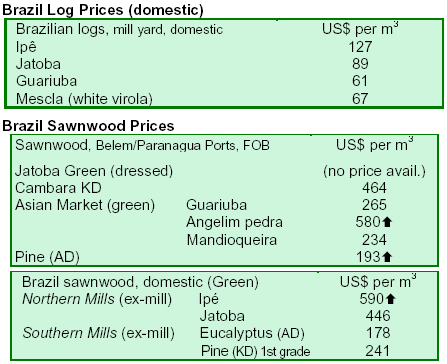
7. PERU
INRENA and ADEX to fulfil commitments under the USPeru FTA
The National Institute of Natural Resource (INRENA) and the Peru Exporters Association (ADEX)
are coordinating efforts to implement actions that will enable Peru to fulfilits commitments under the
forest-related addendum to the US-Peru Free Trade Agreement (FTA). INRENA have
confirmed they are considering having third parties in commercial activities. ADEX has suggested that forest
entrepreneurs will significantly contribute toward reaching USD3.5 million in lumber exports.
Lumber exporters fear possible US sales reductions
President of the Lumber Exporting Committee of ADEX, Mrs. Misha Torres, expressed concern that
sales to the US could considerably drop due to the conditions established in Peru-US FTA
addenda. She said most of the local stocks of lumber, valued at over USD20 million, were
stuck at docks due to delays in processing paperwork associated with exportation. She also noted that even
though an 18-month period was given to adjust Peruvian regulations to meet US demands, this
period has actually been reduced by half. According to Torres, the total lumber exports increased to
USD216 million in 2006, of which 40% corresponded to US sales.
Peruvian forest conservation efforts praised
The American journal Science congratulated Peru for its forest conservation efforts, noting that
Peruvian policies were key to preventing forest degradation and destruction.
The study was carried out using the Carnegie Landsat Analysis System (CLAS). More information on the study
can be found in TTM 12:15.
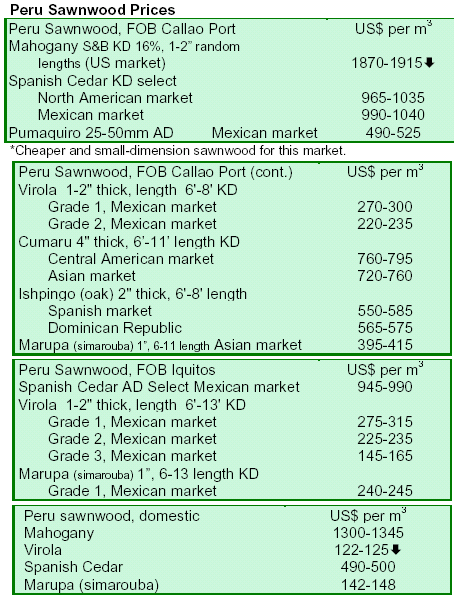
8. MEXICO
Mexico shines in community forestry
Mexico¡¯s experience in addressing community forest enterprises (EFC) during the last 25 years
shows its strength at the global level, largely due to Mexico¡¯s stronginstitutional and
legalframework. Mexico has legislation guaranteeing communities the right to use their own forest
resources. The country also mobilizes support and resources for forest communities through
government programmes.
Mexican achievements in community forestry were recently highlighted at the ITTO Conference on
Community Forest Enterprises, held in Rio Branco, Brazil. Specifically, the Community Forest
Development (PROCYMAF) programme was designed to work for communities and operated in the
main forest states of the country where there were a great number of communities.
Many important components of PROCYMAF had been incorporated into ProTree, the main programme of the
federal forest administration in Mexico.
9.
BOLIVIA

10.
GUYANA
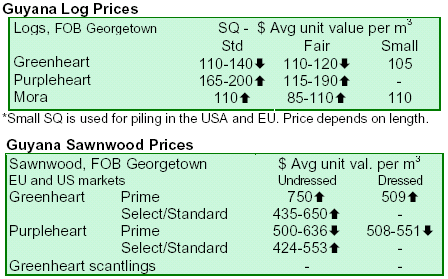
|